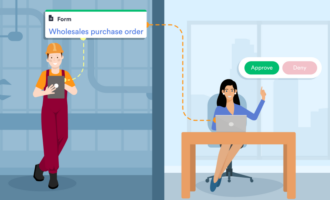Online shopping and e-commerce have become a big part of how people buy products. Whether you need to get groceries or a new rug for your home, it’s likely you’ll first shop at an online retailer. Each time you place these orders, you get an email confirming the retailer has received your request, along with purchase and delivery information.
When it comes to businesses buying goods for their operations, the process is very similar. A company creates a purchase order to request needed goods from a supplier. That supplier creates a sales order, a receipt listing these goods.
It’s important for business owners to understand the purpose of a sales order vs a purchase order. This knowledge can help you create a smooth procurement process and keep your business organized.
Two workflows
Every business that buys and sells goods uses both purchase orders and sales orders. In comparing a sales order vs a purchase order, business owners should understand how each of them work, as one doesn’t exist without the other.
The differences between a sales order and a purchase order define the relationship between them. Sending a purchase order is one of the last steps in a purchasing workflow. Once the buyer files the purchase order — which includes the items requested, the quantities, and their cost — and the supplier agrees to it, it becomes a legal contract.
On the other hand, a supplier sends a sales order to a buyer to confirm an order request before they deliver the goods, completing a step in their sales workflow.
For example, if a local park wanted to buy soccer nets for its new field, it would send a purchase order to a sporting goods provider. Once both parties agreed on the sales terms, the provider would send a sales order — a receipt of purchase — to the park detailing the same information found in the purchase order, along with an expected delivery date.
Different types of communication
There are a few steps to complete before these forms intersect. In the purchase order process, a company typically deliberates internally about the exact request it will send to a supplier.
You and your team have to discuss what you’re asking for and why you’re asking for it. Make sure you don’t overcompensate — or fail to order enough goods — to keep your operations moving.
Once that’s settled, communication shifts externally to another company. After you agree to terms about what the supplier will deliver, they’ll send a sales order detailing what your business is going to receive — a simple document that reasserts the contract both sides have entered into.
If these processes are done efficiently, neither company should have to wait long to receive the correct forms.
Separate approval processes
The methods you use to work with your internal teams are going to differ from the ones you use to work with a supplier. Whatever the methods, it’s important to be precise and ensure you’re organized.
A supplier might not have the same approval processes as your business, so make sure you get everything correct in your purchase order — even down to the fine print — by going through the proper approvals. That way, once a supplier sends over a sales order, there won’t be any confusion or need to retrace steps.
If you work for a large company that needs a part for a new product that only a smaller, specialized vendor can provide, your purchase and receipt approvals should be in sync to eliminate any bumps in the purchasing process.
Established databases
A purchase order triggers a sales order, so for every purchase order, you’ll have an accompanying sales order to file away for future reference.
If a company decides to place recurring purchase orders for a product it uses frequently, it can access the original purchase order to check cost information and help with budgeting. On the flip side, the supplier can log payments it receives from a buyer to chart its profit growth.
An organized business keeps proper records for purchases and incoming orders in a detailed database. If you don’t know what your inventory looks like, you won’t be able to determine if you need additional supplies.
A supplier that doesn’t track transactions won’t have a way to project earnings. Whether you’re completing a sales order or a purchase order, saving those forms will help you stay on top of your business and create a living database of your day-to-day operations.
Automate your workflow with Jotform
Handling a large volume of transactions is difficult to do manually, which is why finding a program to automate the process can help you streamline your workflow. Enter JotForm.
Whether you’re creating a sales order or a purchase order, Jotform provides carefully designed templates for you to conduct your business. What’s more, Jotform’s Assign Forms feature allows you to define who’s in charge of handling orders and requests to make sure everyone on your team understands their responsibilities.
The icing on the cake is Jotform Approvals, which allows you to create a detailed visual workflow and designate individual team members as approvers. And communication capabilities via Jotform Inbox enable you to stay on top of the work that your team still needs to do.
If you’re looking for a centralized location to reference purchasing information, look no further than Jotform Tables. All form submissions automatically populate the associated table in Jotform Tables. You can also create reports with the Report view to analyze your purchasing history. And if you need to work on the go, you can use Jotform Mobile Forms.
No one likes to scramble when it comes to buying and selling. When you automate your purchasing process, it’s easy to save purchase records. You’ll free up time for you and your employees, and you’ll be grateful for automation when your business toasts to its success.
















Send Comment: